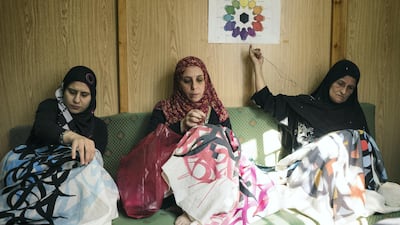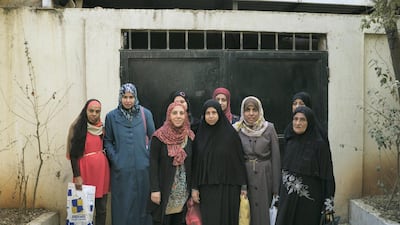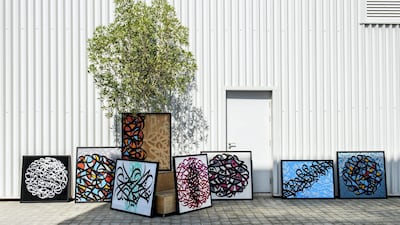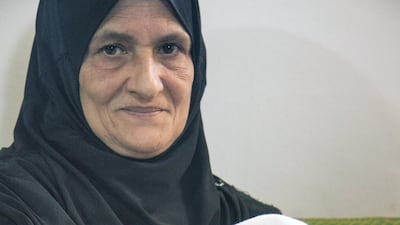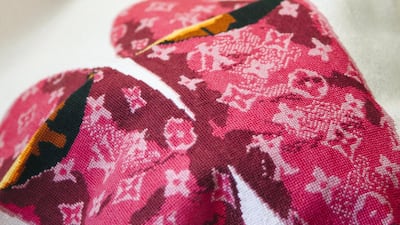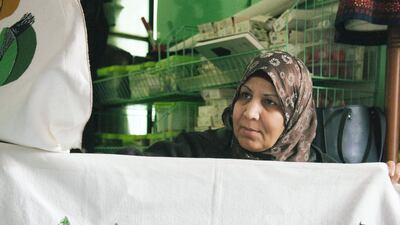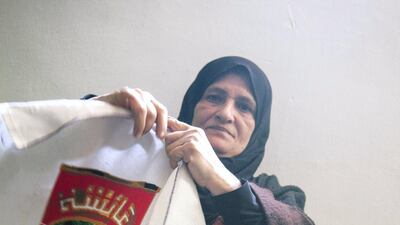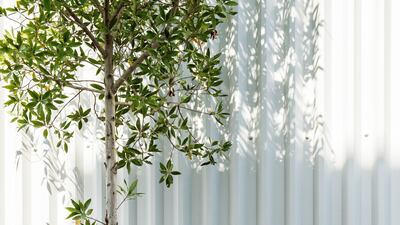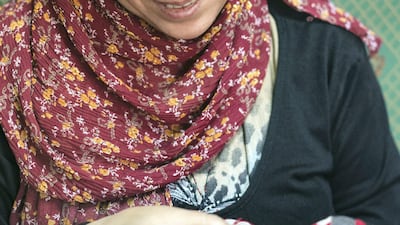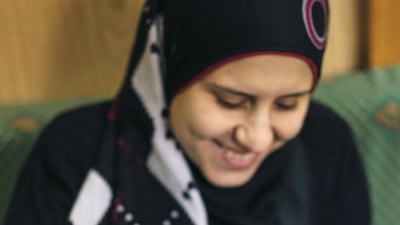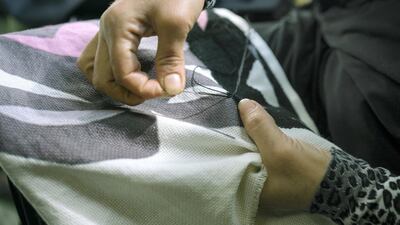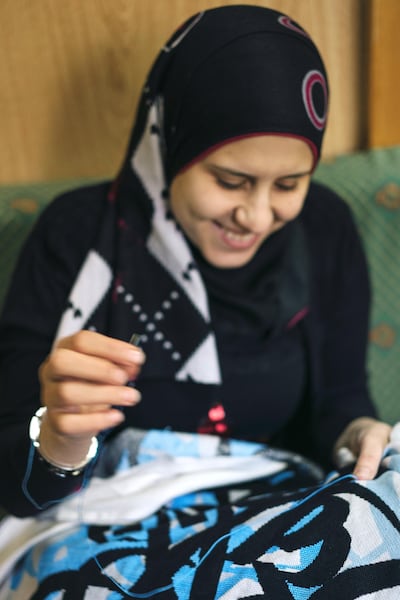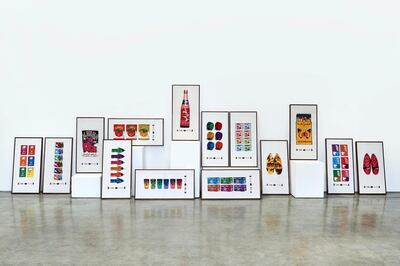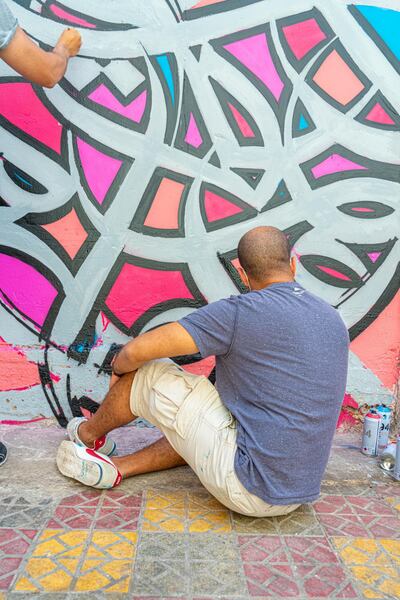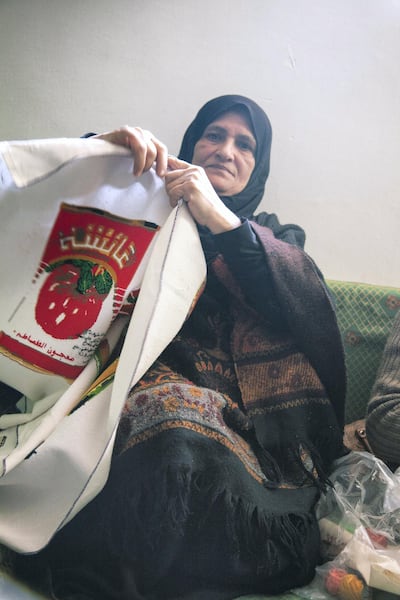In an area the size of a square kilometre, 120,000 people live, work and survive. The largest refugee camp in Lebanon, Ain Al Helweh, was established in 1948 after the Nakba forced hundreds of thousands of Palestinians to flee their homes. Over the years, the camp’s population has ballooned from 70,000 after the Syrian Civil War in 2011 brought in more displaced people.
In the midst of this limbo, life goes on – food markets open, businesses operate and schools hold classes. It is also here that a group of Palestinian women are not only making a living from the traditional embroidery craft of tatreez, but are modernising it with a mix of contemporary art.
Um Mahmoud is one of these women. She is the lead artisan for 81 Designs, a social enterprise that employs craftswomen to work on collaborative projects with contemporary artists using tatreez. Her parents fled Palestine in 1948, when her mother was only two years old and her father aged eight, and ended up in Ain Al Helweh. Born and raised in the camp, Um Mahmoud is now bringing up five children of her own there.
"Life in the camp is difficult because of poverty, deprivation, security, high population, high unemployment rate, banning Palestinians from work … there are many reasons which make Ain Al Helweh dominated by poverty," she tells The National. Speaking to Um Mahmoud was not an easy task – cellular reception is usually unreliable inside the camp, so messages had to be relayed to her son via WhatsApp voicenotes.
Through 81 Designs, she and the other artisan refugees have worked with international artists such as Hassan Hajjaj, known for his Pop Art works with a Middle Eastern flair, and eL Seed, whose graffiti projects have transformed public spaces across the world. Often, the craftswomen are tasked with translating the artists’ styles into embroidery on different materials, and the final results have been on sale at art fairs such as Art Dubai and Abu Dhabi Art.
The idea of fusing contemporary art with traditional craft comes from 81 Designs co-founder Nadine Maalouf, who is based in Abu Dhabi and whose background is in art history. “I always wanted to find a way to work with a humanitarian cause through art,” she says. She initially wanted to work with NGOs, pitching her proposal for artist-artisan collaborations, but “they couldn’t grasp it," she explains. "They couldn’t even imagine why [the artisans] would do that.”
She also found the commission model – where craftswomen would only get paid once they sold a product – unsatisfying. So, in 2015, she started her own venture with her mother, Nesrine El-Tibi, who mostly oversees operations in Lebanon while Maalouf develops partnerships with artists and art organisations from the UAE. They began looking for artisans and found Um Mahmoud through a consultant. Impressed by her craftsmanship, Maalouf wanted to bring her on onboard, but Um Mahmoud had her doubts. “At first, we thought that the job [she offered] doesn’t match ours," she admits. "We produce pieces that pertain to heritage and traditional items. Even the stitches are traditional. Their art is modern and completely different. But then we thought this can be a good combination of modern art with Palestinian weaving, our culture and what we hold on to."
Four years on, the social enterprise has hired 35 artisans in the Ain Al Helweh camp alone and pays them a monthly wage, a rarity when it comes to employment for refugees.
Their most recent project, The Journey, is a collaboration with eL Seed, who is based in Dubai, and the results will be exhibited at this year's Abu Dhabi Art fair, which runs until Saturday, November 23. Known for combining calligraphy and graffiti elements into what is now known as 'calligraffiti', eL Seed has completed public projects around the world. His most popular is Perception (2016), where he painted on 50 buildings in Cairo's Manshiyat Nasr neighbourhood, also known as Garbage City, where residents are often marginalised by wider society. Viewed from a nearby mountain, the murals formed a circular piece that read: "Anyone who wants to see the sunlight clearly needs to wipe his eye first".
The message of social cohesion and peace endures in the French-Tunisian artist's other projects, such as Lost Walls. This one saw the artist travel around Tunisia, painting murals to highlight the country's culture and history. His work The Bridge featured a 20-metre sculptural work made of reflective steel installed in the demilitarised zone between North and South Korea. In the UAE, the artist created the silvery facade of the Green Planet building in Dubai's City Walk and a permanent installation of calligraphic sculptures in Dubai Opera's plaza titled Declaration.
It isn't the first time he's worked with 81 Designs. In 2017, he worked with the Palestinian artisans for an exhibition at Art Dubai. Back then, however, time constraints prevented him from visiting Ain Al Helweh himself. Instead, the women simply copied print-outs of his work onto embroidery. But the artist felt unsettled about this process, especially after he heard about Hajjaj’s experiences in the camp. “I felt there was something missing. I felt there was no story,” he admits. So he approached Maalouf for another project. This time, he would go inside the camp and paint the walls with the refugees so that they could help to create the work in the first place, before turning it into textiles.
Over the summer, the artist spent a week in Ain Al Helweh and, along with 20 artisans and some schoolchildren, painted murals across seven locations inside the camp, including a section of an UNWRA school building. Armed with spray-paint cans and rollers, the team covered the walls with bright pinks and oranges, following the curves of calligraphy that eL Seed had outlined.
“We were very thrilled,” says Um Mahmoud, who describes eL Seed as “gentle” and “humble”. “He stayed with us for a short time, but he became one of us in one day … He broke the barrier between us, so he became part of the team.”
In his work, eL Seed often draws quotes from poets such as Mahmoud Darwish, whose words touch on exile and the Palestinian struggle – and he chose to do the same in this project. It was a meaningful choice for the women in the camp, who despite never having lived in Palestine, feel the loss of their land all the same. “We felt the impact of every word that was being written," says Um Mahmoud. "Because it reflected our daily lives. The poet described the life of the Palestinian people and the deepest feeling of every word was reflected on the murals."
After eL Seed’s visit, the work for the women really began – the next few months were spent stitching the designs of the murals onto large-scale canvasses that are now hanging in Manarat Al Saadiyat for Abu Dhabi Art visitors from around the world to see.
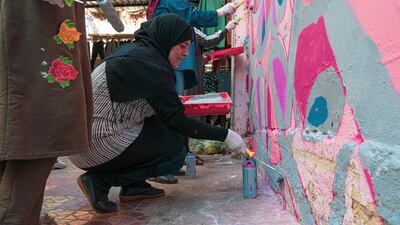
For eL Seed, working with the artisans in person created more intimate art. “That is what was important for me, that they’re connected with the work and that they’re creating as well."
Um Mahmoud agrees this was important. “It was our first time to do this kind of art ... During the period [eL Seed] was here, we were looking for walls in the camp. Now, every time we find a wall suitable for a painting, we know it’s the right one because of what he said and how he chooses. It was a journey of innovation and change of routine. The team was extremely happy. Actually, he is welcome anytime with or without a project because we were very happy with him."
Thankfully, Um Mahmoud and her fellow artisans are just a handful of people who are now modernising the art of tatreez. For example, Palestinian-American artist Jordan Nassar works with craftswomen in the West Bank to stitch painterly landscapes reminiscent of Etel Adnan’s canvasses, and Jameel Prize 5 shortlisters Naqsh Collective carve traditional textile patterns onto materials such as wood and brass. “I have never understood why [tatreez] was only presented in a certain medium,” says Maalouf. “It’s done beautifully on clothing, but why not give it another platform to be presented?” Through 81 Designs, she hopes to “preserve” and “modernise” the practice, but more importantly provide opportunities for refugee women. “Now it’s more impactful for us and for the ladies … It’s an entirely different motivation behind the enterprise”.
None of these projects are about pitying refugees, eL Seed is quick to point out. "That's not the point at all," he says. "The point was really to show the strength that these women have and the courage that they have, to find that most of them are the people who provide for their families.”
Um Mahmoud is a living example of this strength, and has taken on the role of mentor to other young women also making a career out of traditional craft. She also teaches sewing and weaving courses in different centres around the camp. “81 Designs has impacted us since we started implementing projects with them, she explains. "Many things have changed. They have supported us financially. Women are now able to pitch in for home spending and their children’s school fees. They feel productive.
“It is not only financial gain, but it has also widened our work scope. They [Nadine and Nesrine] have been involved in our personal lives and have become part of us. We feel that we are supported, that someone is backing us and we are not working alone.”
